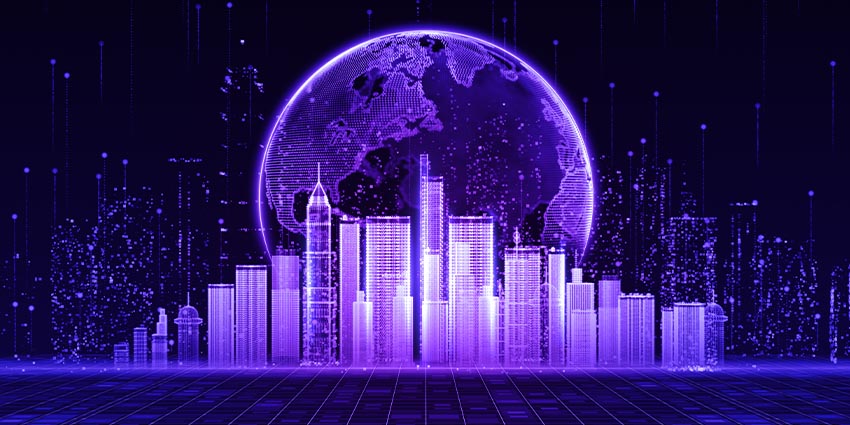What is the Industrial Metaverse? The Full Guide

What is the industrial metaverse, and is it the key to unlocking the total value of metaverse environments? In the last year or so, the sudden hype around “metaverse” technologies has begun to wane. Foremost market leaders have canceled or delayed metaverse projects.
Even Meta, the company most commonly associated with the “rise of the metaverse,” seems to have lost some interest. Many of today’s companies have jumped to a different hype train, focusing on generative AI and LLMs.
However, there is still a place where the metaverse is thriving – the industrial landscape. The industrial metaverse, considered the “next generation of Industry 4.0, ” already influences how products, buildings, and cities are designed.
Some experts even predict this aspect of the metaverse could be worth more than $400 billion by 2030. But what is the Industrial metaverse, how does it work, and what are its benefits?
Defining the Metaverse: From Consumer to Industrial
The Metaverse is often (mistakenly) perceived as a single, all-encompassing virtual world wherein various companies create digital experiences. However, the reality is the “metaverse” isn’t one entity. It’s a collection of different metaverses built on decentralized technology for unique purposes.
The most commonly referenced “type” of metaverse” is the consumer metaverse, popularized by environments like Roblox and Decentraland. In this landscape, the primary focus of the metaverse is on social interaction and entertainment.
Elsewhere, we have the “enterprise” metaverses used for work and collaboration. Meta’s Horizon Worlds metaverse is a basic example of this. In enterprise metaverses, companies create digital twins of offices and other environments and align employees with virtual tools and communication apps.
The industrial metaverse, on the other hand, is focused on optimizing the operations and processes of various industries. Using extended reality technologies, artificial intelligence, and the Internet of Things, this metaverse empowers industries to cut costs and act more sustainably.
What is the Industrial Metaverse? The Basics
The industrial metaverse combines various aspects of the “metaverse” landscape” to support companies in optimizing manufacturing, supply chains, and performance. The term is commonly applied to cloud-based applications designed for business users.
Like the enterprise metaverse, the industrial metaverse helps organizations accelerate operations, boost collaboration, and streamline everyday processes.
Enterprises and public sector agencies can test and optimize their systems, infrastructure, and processes within these metaverse spaces to identify and fix issues. Many industry experts view the industrial metaverse as the “next phase” of Industry 4.0.
For those who don’t know, Industry 4.0, a term popularized about a decade ago, refers to deploying technologies with the potential to enhance industries. For instance, elements include advanced networks, cognitive tools, digital twins, and advanced robotics. Even the blockchain is involved in some Industry 4.0 efforts.
Many of these technologies are also present in the vision for the industrial metaverse. Industrialized metaverse environments aren’t just digital simulations or VR apps. They combine extended reality with artificial intelligence, IoT, and collaboration and interaction tools.
How Does the Industrial Metaverse Work?
The metaverse isn’t a single platform or solution for building next-gen experiences. It’s a collection of innovative tools and applications. It combines blockchain technology with AI, networking solutions, and IoT.
The most common solution connected with the industrial metaverse is the “digital twin.” Digital twins are virtual representations of real-life processes, objects, and systems.
These technologies are already standard in the industrial landscape. They’re used to perform practical tasks, such as system monitoring and maintenance. However, the industrial metaverse will take these digital twins to a new level. While initial digital twins were intended for basic plant operations, such as increased automation or training, twins in the metaverse will accomplish more.
The Internet of Things, which allows information to be exchanged between networks and physical objects, will power the creation of the “Internet of Twins.” Here, workers will be able to carry out co-simulated projects at scale. For instance, digital twins could one day manage and enhance entire end-to-end industrial systems.
In the industrial metaverse, people, systems, equipment, and products will connect dynamically, leading to exceptional innovation.
While the digital twin is one of the core parts of the metaverse, it’s not the only feature. A comprehensive metaverse relies on extensive computing power, faster networks, artificial intelligence, and advanced extended reality technologies.
Already, innovations are emerging to power more of the industrial metaverse. 5G connectivity allows for the rapid transmission of data between devices. Ultra-fast, high-speed networks, and edge computing solutions are emerging at scale. Extended reality tools for mixed, virtual, and augmented reality are becoming more powerful.
Who is Building the Metaverse for the Industrial Sector?
Though a comprehensive “industrial metaverse” is still being developed, many major vendors are already playing a role. At Microsoft Inspire 2023, Microsoft announced it would enhance its industrial metaverse initiative.
The company plans to leverage digital twins (powered by Azure) and cloud-to-edge technologies, simulation, AI, and mixed reality to create metaverse solutions for industrial companies. Elsewhere, companies like Nvidia are producing tools like the “Omniverse.” This will give companies access to a cloud-based metaverse hub.
The omniverse cloud-based service will support tools for connecting, building, and operating AI-based avatars, digital twins, and automation services. An as-a-service model will also open the door to metaverse access to a broader range of companies.
Nokia, a major telecommunications brand, invests heavily in the metaverse. The company is quickly becoming one of the leading vendors responsible for creating and installing the infrastructure the Industrial metaverse will need. Nokia’s Digital Automation platform already offers an environment for industrial digitization.
This platform includes access to various wireless connectivity solutions, certified devices, industrial edge computing, and applications.
Why is the Industrial Metaverse Important?
So, why is the industrial metaverse so valuable?
Like all forms of the metaverse, the industrial sector aims to transform how we interact with each other and emerging technology. However, the focus on the industrial landscape means this type of metaverse could have a much larger impact on our lives than most realize.
The metaverse is a digital world that’s always on and operating.
It’s where real machines, factories, grids, transportation systems, and cities are consistently mirrored in a virtual world. Innovators have new opportunities to find, analyze, and fix problems quickly in this digital environment. Some issues can even be resolved before they occur.
In the Industrial metaverse, all this innovation will happen in a world that enables a new level of immersive collaboration. People can break through geographical barriers and work together across continents and countries. Everyone can experiment with new ideas quickly and easily without investing in physical resources or encountering risks.
To put the potential into perspective, look at Siemens’ Digital Native Factory in Nanjing. Planned using the latest digital technologies, the entire factory has its digital twin. This twin helped to optimize the creation of the building and mitigate problems from day one.
The continued use of the simulation technology during operations also significantly enhances performance. Manufacturing capacity was increased by 200%, and productivity increased by 20%.
Who is Using the Industrial Metaverse?
Siemens isn’t the only example of a company leveraging the power of the industrial metaverse.
A survey of 350 senior leaders across manufacturing firms in the US revealed that 92% are already using metaverse technologies. For instance, digital twins and 3D modeling tools have been implemented by 33% of firms already. For most companies embracing the industrial metaverse, the main focus is manufacturing production enhancements.
Investments here focus on real-time monitoring, digital twins, process simulation, and virtual prototyping. Around 20% of respondents also said they were already using factory simulation.
Companies are also using the metaverse to build tools for human resources purposes, such as immersive training and virtual plant tours. Plus, the same technologies support supply chain management, logistics, and even customer-facing systems.
Examples of organizations investing in the industrial metaverse range from Hyundai, who partnered with Unity to design a metaverse roadmap, to NASA. The NASA team is currently working with metaverse environments with HoloLens technology.
The Use Cases for the Industrial Landscape
The variety of powerful tools and technologies offered by the industrial metaverse paves the way for many use cases. The industrialized metaverse can empower companies to improve operations with digital twins, using real-time data to minimize risks and streamline processes.
The industrialized metaverse can also tackle several challenges facing the industrial landscape today. After all, industrial landscapes are growing increasingly more complex.
Automating processes, leveraging AI, and building simulations in virtual landscapes can help employees perform more effectively. The industrial metaverse is set to enhance both productivity and collaboration significantly. Plus, it will enable new levels of innovation.
The metaverse can also be a secure setting for experimenting with innovations and opportunities. It can be a testing ground for new automation and AI-driven solutions. For instance, companies can use metaverse environments to test how new materials will work in production or how specific workflows will help to improve productivity and employee safety.
On top of all this, the metaverse will help industrial companies tackle complex labor issues, making it easier to recruit and train new team members. It could even significantly reduce carbon emissions and the impact human beings have on the environment.
After all, with the industrial metaverse, experts can work remotely from anywhere, reducing the need for travel. Products and machinery can be developed virtually rather than in the real world, reducing waste. Additionally, spatial analytics will give companies insights into operations and performance metrics that can significantly reduce energy consumption.
The Road to the Adoption
While aspects of an “industrial” version of the metaverse already exist worldwide today, there’s still a way to go. Many tools that facilitate the development of the industrial metaverse have already been around for a while, and they’re commonly used in a siloed format.
According to Forrester’s analyst, Paul Miller, very few companies combine all of the elements of an industrial metaverse together simultaneously. An entire metaverse would require companies to do more than just adopt virtual reality and digital twins.
However, progress is happening at quite a rapid pace. The ongoing development of new “metaverse standards” should pave the way to better interoperability and growth. Of course, challenges still exist, such as managing the cost of implementing a metaverse environment.
According to Deloitte, 51% of manufacturing companies are concerned about the expense of a metaverse ecosystem, while 50% are worried about a lack of skills and relevant talent.
At the same time, there are still risks to address, particularly regarding cybersecurity. The more connected processes and technologies become, the more potential issues businesses must address to secure their data.
The Metaverse of the Future
The industrial metaverse is on its way and may arrive even faster than the “consumer metaverse” so many people are looking forward to. According to the Deloitte study mentioned above, more than 70% of respondents believe metaverses for industrial companies will see high adoption in the next five years.
Companies of all sizes believe this innovative new technology will improve supply chain performance, employee productivity, and speed to market. It will also help companies increase revenue and deliver advanced customer service.
As innovators worldwide continue experimenting with metaverse solutions, the industrial version of the metaverse could become the first example of a “true” metaverse in the years ahead. While consumer and enterprise metaverse still absorb most of the market hype, the industrial solution could have the biggest impact on the world.
Source link
#Industrial #Metaverse #Full #Guide





